The Structure of the Electric Guitar
[Experiment] Let's make and then test several coils
Performing a sound experiment
It was mentioned earlier that the number of times a coil is wound and even how it is wound (pitch, etc.) can have a significant effect on the timbre and volume. A coil does not need to be wound thousands of time for this change to be noticeable-even 200 times is enough. Let's give it a try.
Experiment steps
-
1.Set nuts and washers to a bolt, then wind it with enamel wire.
* In this experiment we used a coil wound 100, 200, and 330 times around a 4 cm long bolt, then a coil wound 330 times around a 2 cm long bolt.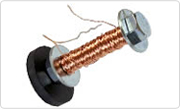
-
2.Attach a round magnet to the bottom of the bolt.
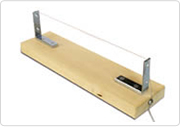
-
3.Connect the enamel wire to a cable, then plug the cable into the amplifier.
-
4.Create a stand using a board and metallic L-fixtures, and string a single steel string between them.
-
5.Use a board or the like to set the coil so that its top is several millimeters below the string.
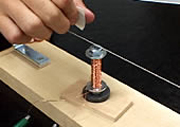
-
6.Turn the amplifier on, pluck the steel string with a pick, and listen to the sound.
Compare the volume of each coil with a different number of windings
What happens to the sound as the number of windings increases? We compared 100, 200, and 330 windings.
100 windings:
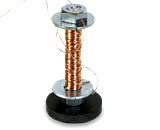
200 windings:
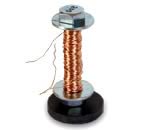
330 windings:
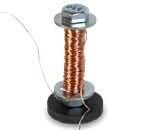
* As this was an experiment, the recorded pitches differed from the correct notes.
When the string was plucked without the amplifier turned on only a quiet sound was heard. Once the amplifier was turned on and the volume increased, a much louder sound was heard. Switching out the coil showed that the volume definitely increased along with the number of windings in the coil. As the number of times a coil is wound is increased, the output increases, causing the sound to get louder. Conversely, winding a coil too much makes it more difficult to produce sound. However, at only 200 or 300 windings, there is still room to increase the volume with more windings.
Compare the volume between one coil and two coils
We next compared a single coil wound 200 times and two coils wound 200 times, to see what would happen if the number of coils increased.
Results of the experiment
One coil:
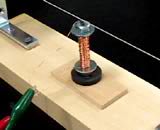
Two coils:
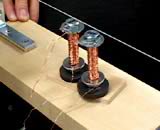
* As this was an experiment, the recorded pitches differed from the correct notes.
Although using two coils did not double the volume, it did make the sound noticeably louder. Incidentally, when two coils are wound in the same direction, first connect the ends of each enamel wire together, and then connect the other end of each to the cable going to the amplifier. The two bottom magnets will then have their S and N sides lined up upside-down. It can be very interesting to experiment with these coils!
Compare the timbre of two coils with the same number of windings but different thicknesses
Let's compare a long and narrow coil with a thick coil to see how the timbre changes when a coil is wound differently.
Results of the experiment
Long and narrow coil wound 330 times:
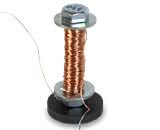
Thick coil wound 330 times:
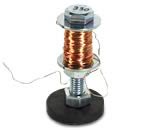
* As this was an experiment, the recorded pitches differed from the correct notes.
Although the difference is very slight, the long and narrow coil produces a light sound that is cleaner, while the thick coil generates a sound that has a more well-rounded feel to it. The difference in timbre would likely be more noticeable if the coils were wound more. The coils in actual electric guitars are wound several thousand times, so the timbre changes quite dramatically depending on the way the coil is wound.
Coil and string position experiment
Plucking the string while moving the coil and magnet showed that the best sound was produced when the coil was directly underneath the string. This shows how important the distance between the coil and string is. Watch the video below to hear how the sound changes as the coil is moved.
The experiment
Long and narrow coil wound 330 times:
* As this was an experiment, the recorded pitches differed from the correct notes.
Musical Instrument Guide:Electric Guitar Contents
Structure
How to Play
How the Instrument is Made
Choosing an Instrument
Care and Maintenance
Trivia
- Slide guitar playing may have been invented in a bar
- Feedback:Great for guitar playing! Not so great for karaoke...
- What is the difference between an electric guitar and electric acoustic guitar?
- Is there a way to eliminate the noise heard when plugged into an amplifier?
- Whole note down tuning for deeper bass
